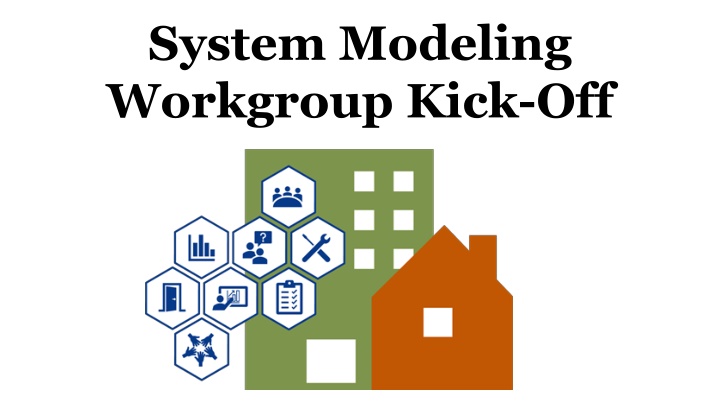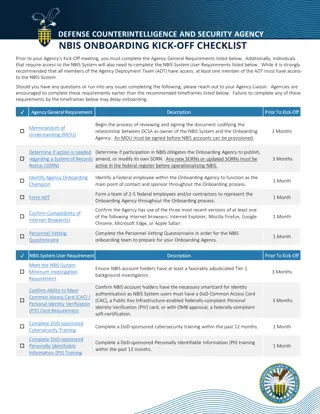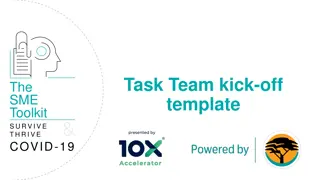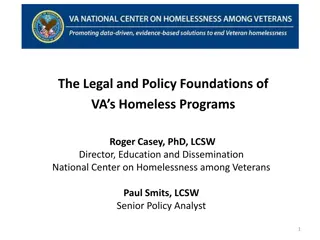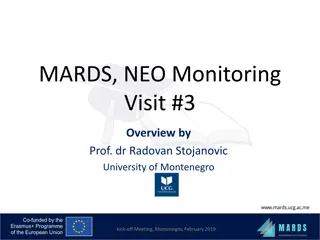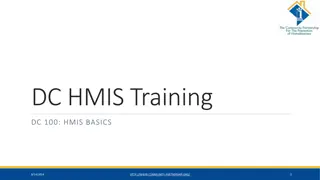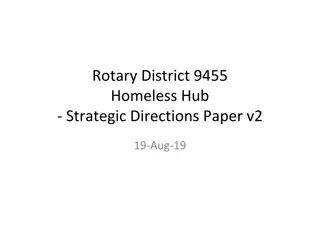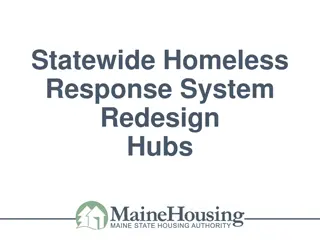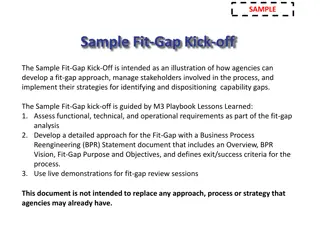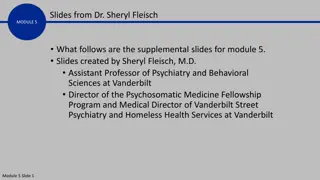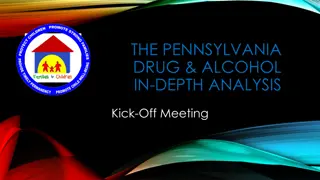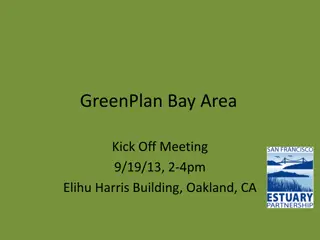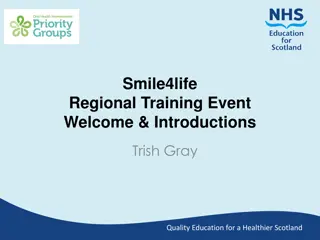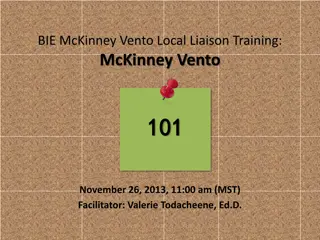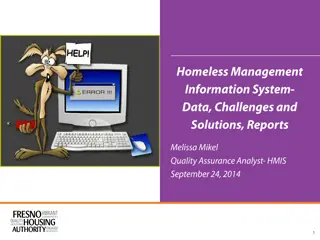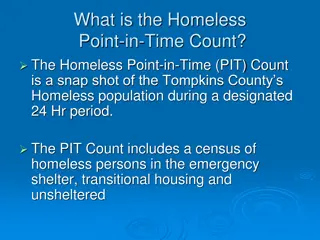System Modeling for Homeless Response: Kick-Off Meeting Insights
Explore the key aspects of the system modeling workgroup's kick-off meeting, including agenda highlights, discussions on system modeling goals and purpose, developing a shared vision, and even a fun pizza activity that ties back to the homeless response system. Gain insights into the structured processes and strategic planning involved in addressing homelessness effectively and equitably.
Download Presentation

Please find below an Image/Link to download the presentation.
The content on the website is provided AS IS for your information and personal use only. It may not be sold, licensed, or shared on other websites without obtaining consent from the author.If you encounter any issues during the download, it is possible that the publisher has removed the file from their server.
You are allowed to download the files provided on this website for personal or commercial use, subject to the condition that they are used lawfully. All files are the property of their respective owners.
The content on the website is provided AS IS for your information and personal use only. It may not be sold, licensed, or shared on other websites without obtaining consent from the author.
E N D
Presentation Transcript
System Modeling Workgroup Kick-Off
Agenda Introductions System Modeling Goals and Purpose System Modeling Process Overview Workgroup Roles and Expectations
Introductions Your name and pronouns Your role/title & organization Ice-breaker question
System Modeling Goals and Purpose 4
System Modeling A structured, data-informed process to develop estimates of the size and needs of a population of people experiencing homelessness and assumptions about the types and amounts of assistance (housing, shelter, services) that would effectively and equitably meet those needs.
Develop a shared vision of the optimal system to address the needs of homeless population Goals Model the services and inventory needed to equitably address homelessness Create a transition plan to right-size the system Guide strategic funding and policy decisions for existing and new federal, state, and local funds
Menu Context Setting: The Pizza Order Pizza comes in one size and serves 2-3 adults Cheese Pizza $10 Pepperoni Pizza $12 You are in charge of ordering pizza for an event. Vegetable Lovers Pizza (bell peppers, mushrooms, roasted garlic) $13 Meat Lovers Pizza (peperoni, sausage, bacon) $15 1. How many people do you need to feed? Hawaiian Pizza (pineapple and ham) $14 Large Salad $8 2. What is your pizza order? Gluten-free crust +$3 for each pizza 3. How much is the bill? Vegan cashew cheez sauce +$2 for each pizza
Discussion: What did you decide to order and why?
OK but its not just about pizza, right? Why did we just spend time talking about ordering pizza for a party? What does this have to do with system modeling for a homeless response system?
How does this analogy apply to homeless system response planning? Questions to ask when placing a pizza order Questions to ask when planning a homelessness response system How many people do we need to feed? How many people need housing assistance? What specific needs must our system address? Will people for whom we have designed specific programs use those programs, or will they choose other programs or resources? Does anyone have any dietary restrictions or preferences that will inform what they can eat? Are we making assumptions based solely on our own experience or are we asking diners about their needs and preferences? Have we collaborated with people with lived experience to understand what they would and wouldn t choose, want, and need? What types of assistance (services, project types) does my system need to end homelessness? How much of each type do we need? What types of pizza should we order? How much?
Additional Questions to Inform Your Plan Questions to ask when placing a pizza order Questions to ask when planning a homelessness response system What intensity of services, or length of assistance, will any given person want, need, and use? Will people have eaten before arriving? How much will it cost to fund your ideal and most robust homelessness response system? How much will the ideal pizza order cost? Will or could this be a potluck where people will bring things to eat to complement my pizza order? What mainstream services are available to complement the homeless system s resources? Are my assumptions about inflow, or how many people will come into contact with my system, correct? Will people bring friends with them to the party? Will people who didn t RSVP attend? Have we hosted this event before? What did we order and how did it go? Do we think there will be more or less people than last time? What data do we have that can help inform our assumptions?
System Modeling Process Overview 13
Inputs and Assumptions $ How many people experience homelessness each year? What portion of the population needs each thing? What types of interventions do they need? How long do they need the interventions? How much will this set of interventions cost to serve everyone experiencing homelessness?
System Modeling Key Steps Project Types System Model Households Pathways Define the set of project types needed in an ideal system including current project types and new types. How many households will be in the system each year? How many will be homeless for the first time? How many are long- term homeless? Inventory recommendations Performance benchmarks Cost projections Identify combinations of project types that households will use to resolve their crisis and find and maintain housing.
Develop Project Types Project Types System Model Pathways Households Describes the elements in an effective, efficient crisis or housing intervention to ensure immediate safety and rapid exit to permanent housing as appropriate to the needs of the individual or family experiencing homelessness. Project Type Description Timeframe Population Emergency Shelter Emergency shelter with navigation services (low-barrier, service-rich, housing-focused) 3 months People who need a safe place to stay while looking for housing Rapid Rehousing Time-limited rental subsidy and support services with the intention of the HH taking over the lease 12 months People who can increase income to afford rent Permanent Supportive Housing Permanent subsidies based on income and services to keep tenants stable in housing Non-time-limited People with disabilities who need services Dedicated Affordable Housing Affordable housing resources (subsidies or units) dedicated to households experiencing homelessness Non-time-limited People with extremely low income who can t increase, low /no services needs
Define Pathways Project Types System Model Pathways Households What is a pathway? A combination of projects that a household needs to access and utilize in order to resolve their homelessness How should we think about pathways? Define the common pathways Estimate the percentage of households who will utilize each pathway Estimate the amount of time households will utilize each step in the pathway
Using a System Map to Develop Pathways
Using Cohorts to Develop Pathways A cohort is a group of households with similar characteristics, resources and housing and service needs. Project Types Cohort % Emergency Shelter Rapid Re- housing Dedicated Affordable People experiencing first-time homeless with resources/ supports to self-resolve 20% 1 month Households who have potential to increase income within a year or two enough to pay market rate rent. 40% 3 months 12 months Households unable to increase income sufficiently to afford housing (e.g. working families, older adults on fixed income) with that have a temporary place to stay 10% 5 years Households unable to increase income sufficiently to afford housing that need a safe place to stay while seeking PH 3 months 30% 5 years
Estimate Number of Households Project Types System Model Pathways Households Estimate the annual number of people experiencing homelessness, including people experiencing long-term homelessness and people entering the homeless system each year.
Using Stella Modeling (Stella M) 21
What does Stella M do for CoCs? Stella Modeling (Stella M) Project Types System Model Pathways Households What you need What you get STELLA M Project Types Inventory recommendations Performance benchmarks Cost projections Multi-year transition planning Pathways Households Unit Cost
System Model Project Types System Model Pathways Households Example 10 people enter shelter each month 20% need shelter only for 2 weeks 10% go to TH after 1 month in shelter 50% go to RRH after 1 month in shelter 20% go to PSH after 2 months in shelter 1 bed 1 bed 5 beds 4 beds 11 beds These 11 shelter beds can serve 120 people in a year.
System Model Project Types System Model Pathways Households
System Model Project Types System Model Pathways Households
Workgroup Roles and Expectations 26
Roles and Responsibilities Leadership Group Planning Group Facilitator Workgroup
Work Group Expectations Consistent involvement in workgroup meetings Open to envisioning an optimal system that is different than the current system Report on workgroup progress to peers and leadership within organizations you represent Gather relevant information between meetings to share with workgroup Assume good intentions of fellow workgroup members but own the impact of your words and actions
Workgroup Schedule Date Topic Onboarding (you are here!) Core values discussion & initial project type development Finalize project type list, begin pathway development Listening session with key partners & lived experience advisory board Finalize pathway development Review and discuss households' data and assumptions & preliminary model results Presentation and feedback with leadership group, key partners, and lived experience advisory board Discuss feedback and finalize model
